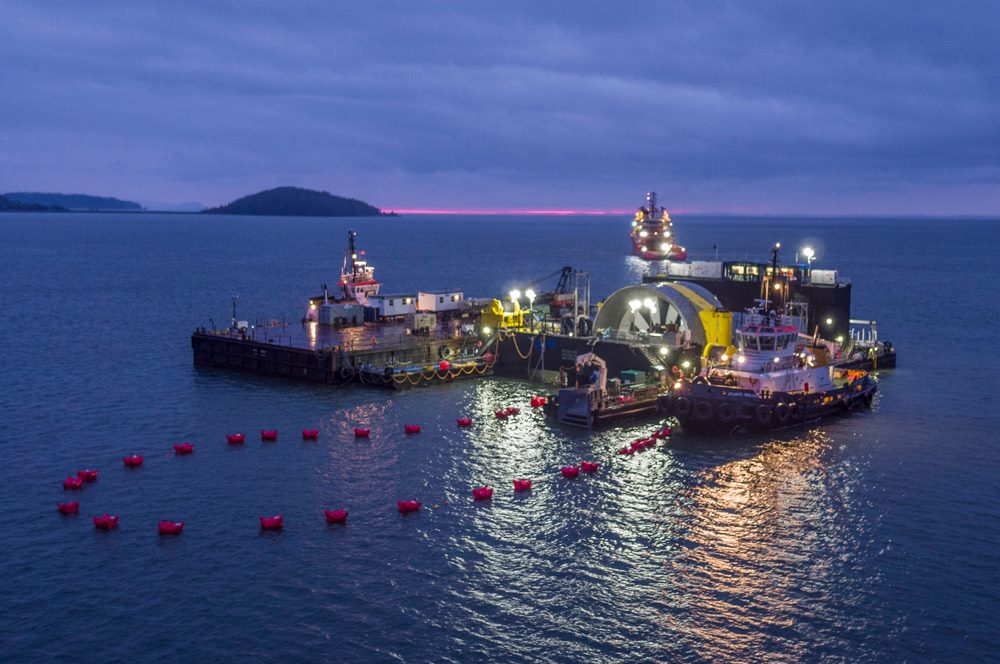This essay is a summary of the presentation held by local Fisherman and Ecosystem Holder, Darren Porter, who was invited in January by the Acadia Department of Sociology to give a public presentation under the same title.
We all remember when Stephen Harper, on behalf of the Canadian people, apologized in parliament to the indigenous people of Canada for the actions and control exercised over First Nation people which lead to the destruction of indigenous life, culture and families. Harper further apologized on behalf of all Canadians for the assumption that aboriginal cultures and spiritual beliefs were inferior and unequal. I remember how good and redeemed we all felt when those words were pronounced right in the parliamentary chamber and were televised across Canada. But now that the healing ceremony is over and the dues are done with an official apology, business can go on as usual. This business being nothing less than 1000 square meters of in-stream tidal power turbines in the Minas Basin Passage. If you really care about apologies for having assumed that aboriginal cultures and beliefs are inferior, then you must question this colossal project being placed right into the heart of Mi’kmaq sacred lands.
The Bay of Fundy (Minas Basin) is not only a significant location for Glooscap, the central figure in the Mi’kmaq creation story but also the site of many other important Mi’kmaq sacred legends like the creation of Glooscap’s Beaver Dam. In other words, the Bay of Fundy including the Minas Basin and Blomidon are the most sacred sites with regard to Mi’kmaq faith and heritage. The sinking of in-stream tidal turbines which will eventually span over 1000 square meters in the Minas Basin Passage would be equivalent to the conversion of Mount Tabor by Nazareth (a revered Christian holy site known as the Holy Mount of Transfiguration) into a green wind farm with 50-meter-tall wind turbines spinning all day and night to produce electricity for export. The Bay of Fundy Glooscap creation legends are to the Mi’kmaq equal to what the testaments in the Bible are to Christians. Preserved from as far back as 3500 years of oral tradition, the Glooscap Beaver Dam creation legend, for example, has been scientifically confirmed and is accurate in location and geological events just as the legend describes. Yet, while no one would ever dream of turning Mount Tabor into a “green” wind turbine farm because the wind blows there, the Minas Basin Passage in the Bay of Fundy is not subject to the same protection because it happens not to be a Christian holy site but only a sacred site for the Mi’kmaq. But it does not end here.
We already have one example of a ‘green energy’ tidal project that was to “save the planet” but instead killed off a whole strain of a fish species and diminished others to the point of no return in the Annapolis River. The Annapolis River Striped Bass is now extinct due to the Annapolis Tidal Power Project and there is no other way to say this but the Annapolis River Striped Bass was destroyed in the name of “green” energy production using tidal power. The extinction of this fish was not foreseen by any government experts and scientists who pushed the project ahead. What is even more concerning is that no lesson has been learned from it either. The Annapolis Tidal Power station should have been shut down and dismantled immediately when it was clear that it would cause fish extinction, but instead an entire genetic strain of fish was sacrificed on the altar of “green” energy.
In the light of these facts, it is time to redefine what “green” really means. Now another one of those “green” energy tidal project is going ahead in the Minas Basin Passage in the very same fashion as was done in the Annapolis River which once was teeming with fish but no more. But this time, not only fish species in the Bay of Fundy could be affected, but the entire livelihood of the Mi’kmaq and local fishermen. Should it happen again that fish are going extinct and/or disoriented by the churning of the turbine blades as with the Annapolis River Tidal Power project, the results would be catastrophic. This is why local fishermen and the Mi’kmaq are asking for input and a voice in this matter.
The main argument voiced in favor of this project is that the Minas Basin Passage is so large that even a square kilometer of turbines will not affect any fish or marine life. This argument is like saying there will be no collisions on the roads since there is so much space all around them and no cars can collide. The fact is that fish follow or let themselves be carried by underwater currents, especially in the Minas Basin Passage where the currents are very strong. This means that fish are moving along corridors created by underwater flows just like people follow roads instead of driving across fields just because the space is there. The fish in the Minas Basin follow such underwater corridors created by currents when they move from the Bay of Fundy into the Basin via the Minas Basin Passage. The problem is that in order to gain maximum efficiency, instream turbines are stationed right there where the currents are the strongest and, hence, end up in the pathway where fish travels. There can be no question that the fish will be battered around by the blades of the turbines which are actually designed to speed up the water currents around them by pulling everything towards them and along with it everything that happens to be in the water.
The fishermen know the routes the fish take but the tidal power experts and bureaucrats do not. They also do not know that you cannot conduct research on lobster in the Minas Basin in the middle of February as it was seriously proposed because there is hardly any lobster there at that time of the year. This is like doing research on the growth of blueberries in February which would undoubtedly lead to the expert conclusion that blueberries are not present and cannot be affected by any human activity. This outcome could then be published in a government report with glossy colored paper to highlight the results. It would be funny if it were not so perilous because those glossy government reports have the power to destroy lives.
All the Minas Basin fishermen want is that honest and unbiased research be conducted on the effects on marine life in the presence of in-stream turbines before they are stationed for good and on a massive scale. All they want is transparency in the process and that their concerns are being considered. All they want is a proper system to monitor marine life and fish kill in and around the turbines. Ecosystems are so fragile and good intentions on the part of those who wish to develop “green”’ energy will not compensate for lost and destroyed species, as we have seen with the Annapolis River Striped Bass. Good intentions will not compensate for the disastrous effect on the livelihood of the Mi’kmaq and fishermen should it all go wrong. The stakes are too high to gamble in the name of a “green” project. Nova Scotia does not need the turbines, but it needs a healthy fishery.
On the topic of green energy: just because energy production does not use fossil fuels or reduces the use of fossil fuels does not make it automatically “green” or environmentally friendly. The best example are those energy efficient lightbulbs that use less energy to give off the same amount of light but contain the highly toxic mercury to the extent that poison control must be called in to decontaminate the premises should the lightbulb break and the toxic mercury be released. These “green” lightbulbs can also not go into the “green” recycling bin but must be decontaminated first which in the end turns out not to be so energy efficient after all. But they are sold to the unsuspecting public as “green” or environmentally friendly because they use fewer fossil fuels.
In other words, just because energy production uses less fossil fuel or renewable energy does not automatically mean there are not dire consequences to the environment. However, we are seemingly willing to march blindly forward under the banner of “green” renewable in-stream tidal energy production without ever having established a baseline to monitor fish kill or other hazardous effects to the Minas Basin ecosystem due to the spinning turbine blades that can hack up fish like machetes, due to pressure changes in the water that can make fish heads explode, due to electromagnetic fields and noise pollution that can cause disorientation in fish. Supreme Court Justice Jamie Campbell made the following statement regarding the installation of the tidal turbines: “when dealing with the environment of the Bay of Fundy, there is no room for error.” If there is no room for error, why then is there no monitoring done regarding the effects on marine life due to the tidal turbines in the Minas Basin Passage? How can we protect the environment without any safeguards to make sure marine life and the ecosystem in the Bay of Fundy are not destroyed due to the in-stream tidal turbines? It seems that all is needed to exempt any environmental monitoring for the protection of ecosystems is to add the label “renewable” and or “green” and everything goes and with that maybe the entire fishery in the Bay of Fundy.
Find more information at: redsky-blacksea.com




